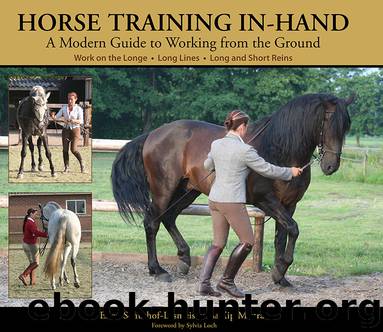Horse Training In-Hand by Ellen Schuthof-Lesmeister

Author:Ellen Schuthof-Lesmeister
Language: eng
Format: epub, pdf
Publisher: Trafalgar Square Books
Goals for This Lesson
Introduce lateral movement
Teach the horse to be obedient to the pressure of the handler and the leg of the rider
Help the horse learn to use his inside hind leg without strain or overreaching
Necessary Equipment
Working cavesson
Bridle with full-cheek snaffle
Surcingle
Side reins (optional)
Short reins (one or two pairs depending on horse’s stage of training)
Cotton longe or lead line (optional)
Dressage whip
Rectangular arena
Thoughts before You Begin
Work in-hand in the short reins requires obedience and responsiveness. The yield to the “leg” is a psychologically powerful lesson to teach a horse. It is a lateral movement that you use not only to supple the horse, but also to teach him respect for your presence next to his body, or your hand pressing against him. Teaching the yield from the ground prepares him to obey your leg when you are mounted. And, it is the building block for the shoulder-in exercise that follows (see p. 101). Since the horse naturally relies upon his hindquarters (his engine) for impulsion to quickly get him out of danger, when you control their movement, you essentially control the horse.
As you begin this lesson, think about how being “pushed” and “pulled” affects a horse psychologically. Horses don’t pull on each other like we pull on them with halters or bridles. They put pressure on and push each other with variations of body language, such as pinning their ears, giving nasty looks, tossing their head, running at each other, snapping at the air, and if all else fails, connecting physically with bites and kicks. When you put pressure on a horse with your expression, body position, hand, leg, or whip—as you’ve been learning to do in the early lessons in this book—you are imposing your personal space on the horse’s space. If you overwhelm him with “pushiness,” he will not be relaxed, because he will always see himself as being on the defensive. You will not be relaxed either, because you will be on the offensive much of the time.
Therefore, think of asking a horse to yield as an invitation—seduce your horse to move away when you advance (and come toward you when you back up!) Always be polite. Give your horse frequent pauses, releasing all pressure, so he has a chance to think about what he has learned and to relax. Be encouraging even when he stops in confusion, makes a mistake, or misbehaves. When you become tense or doubt his abilities (or your own), the horse will notice right away and reflect your mood.
Give the lightest aids possible. You are establishing a precedent: If you start with light aids, adding more pressure only when your horse does not respond, and then gradually back the pressure off, he will follow your lead. If you start and stay “strong and heavy,” he will have no choice but to be strong and heavy, as well.
Be patient, and remember, when the horse yields his body to you with confidence, without fidgeting or resisting, he is demonstrating trust. This is success in itself.
Download
Horse Training In-Hand by Ellen Schuthof-Lesmeister.pdf
This site does not store any files on its server. We only index and link to content provided by other sites. Please contact the content providers to delete copyright contents if any and email us, we'll remove relevant links or contents immediately.
| Equestrian | Polo |
| Racing |
Shoe Dog by Phil Knight(4162)
The Rules Do Not Apply by Ariel Levy(3904)
Walking by Henry David Thoreau(3233)
Running Barefoot by Amy Harmon(3056)
Crazy Is My Superpower by A.J. Mendez Brooks(2857)
How to Read Water: Clues and Patterns from Puddles to the Sea (Natural Navigation) by Tristan Gooley(2851)
I'll Give You the Sun by Jandy Nelson(2841)
How to Read Nature by Tristan Gooley(2662)
How Music Works by David Byrne(2524)
The Boy, the Mole, the Fox and the Horse by Charlie Mackesy(2446)
Seducing Cinderella by Gina L. Maxwell(2233)
Cuba by Lonely Planet(2184)
The Fight by Norman Mailer(2157)
Going Long by Editors of Runner's World(1920)
Accepted by Pat Patterson(1916)
The Unfettered Mind: Writings from a Zen Master to a Master Swordsman by Takuan Soho(1858)
The Happy Runner by David Roche(1819)
Backpacker the Complete Guide to Backpacking by Backpacker Magazine(1814)
Trail Magic by Trevelyan Quest Edwards & Hazel Edwards(1760)
